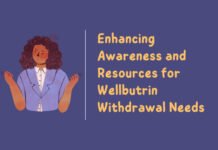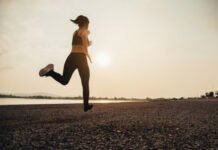
Are you ready to transform your yoga practice? Whether you’re a beginner embarking on your yoga journey or a seasoned yogi seeking to deepen your practice, incorporating yoga blocks can open up new dimensions. In this comprehensive guide, we’ll delve into the myriad benefits of yoga blocks, explore their versatile applications, and provide detailed instructions for beginner-friendly yoga block exercises. Elevate your practice and experience the magic of yoga blocks.
1. What Are Yoga Blocks?
Yoga blocks are essential props made of foam, cork, or wood, designed to enhance your yoga pose and practice. These rectangular wonders come in various sizes, offering support, stability, and balance during poses.
2. Benefits of Using Yoga Blocks
Exploring the Advantages of Yoga Blocks:
Improved Flexibility:
- Yoga blocks facilitate safe stretching with proper alignment, gradually increasing flexibility.
- In simple poses like Sukhasana, placing a block under the hips creates height, promoting spinal lengthening.
Increased Strength:
- By encouraging correct alignment, yoga blocks help engage intended muscles, enhancing strength and endurance.
- Consistent use during poses like Warrior II builds muscle adaptability and strength.
Better Balance and Support:
- Blocks contribute to stability during challenging poses, such as Ardha Chandrasana (half moon pose), where a block can provide shoulder support.
- Improved balance allows practitioners to focus on alignment and form.
Accessibility:
- Yoga blocks modify poses, making them accessible for those with physical limitations or injuries.
- For instance, placing blocks under hands in Parsvottasana (pyramid pose) brings the ground ‘up towards’ practitioners, creating space.
3. How to Use Yoga Blocks
Unlock the Benefits of properly using yoga blocks:
Support and Stability:
- Place blocks under hands or feet in foundational poses like Adho Mukha Svanasana (downward facing dog) for added support.
- Creating space in the body allows for better form and reduces pressure on joints.
Increase Height:
- Elevate the floor using blocks to make poses more accessible, allowing practitioners to focus on breathwork and form.
- Experiment with different block positions to find the optimal height.
Modification:
- Modify poses using blocks for accessibility or increased challenge.
- In Eka Pada Rajakapotasana (pigeon pose), placing a block under the hip enhances accessibility for those with limited hip mobility.
Alignment:
- Achieve proper alignment and form in poses relying on flexibility rather than muscle engagement.
- For Virabhadrasana II (warrior II), placing a block between thighs activates inner thigh muscles, improving alignment.
Restorative Poses:
- Use blocks to support the body in restorative poses, enhancing relaxation.
- In Setu Bandha Sarvangasana (supported bridge pose), a block under the lower back relieves tension.
Yoga Block Exercises for Beginners
Introducing an invigorating series of Yoga Block Exercises designed specifically for beginners:
1. Bird Dog Pose

- Start on hands and knees.
- Place a block under the left hand and another under the right knee.
- Extend left leg and right arm.
- Straighten your left leg behind you, parallel to the ground.
- Engage the core for balance and lengthen the pose.
- Keep your abdomen firm to stabilize your spine and elongate your body.
- Repeat on the other side.
2. Dead Bug Pose

- Lie on your back.
- Place a block between the left elbow and left knee.
- Squeeze the block gently to engage the inner thighs.
- Inhale as you engage your abs, bringing your right elbow towards your right knee.
- Lift your head and shoulders off the ground.
- Exhale, extending elbow and knee.
- Lower your head and shoulders back down.
- Repeat on the other side.
3. Triceps Pushup

- Start in the pushup position with blocks under the shoulders.
- Lower down, tapping the blocks.
- Control the descent to engage the triceps and chest.
- Engage the core and push back up.
- Ensure a straight line from head to heels.
- Modify by bending knees for beginners.
- Reduce difficulty by keeping your knees on the ground.
4. Plank IYTW
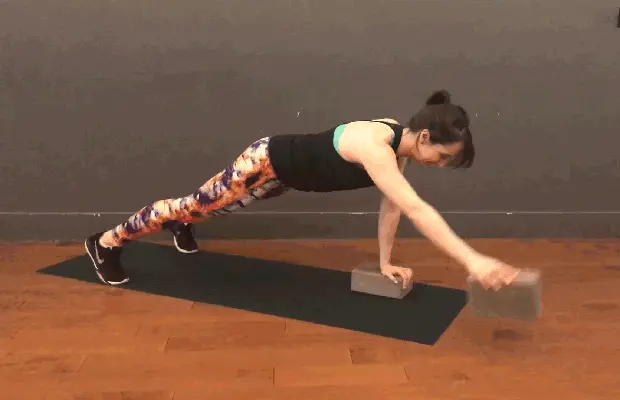
- Start in a high plank with a block under your left hand.
- Lift right arm for I, tap down, lift for Y, wipe down, raise for T, tap down, raise for W.
- Focus on controlled movements to engage different muscle groups.
- Maintain a strong plank throughout.
- Repeat on the other side.
5. Flying Plank
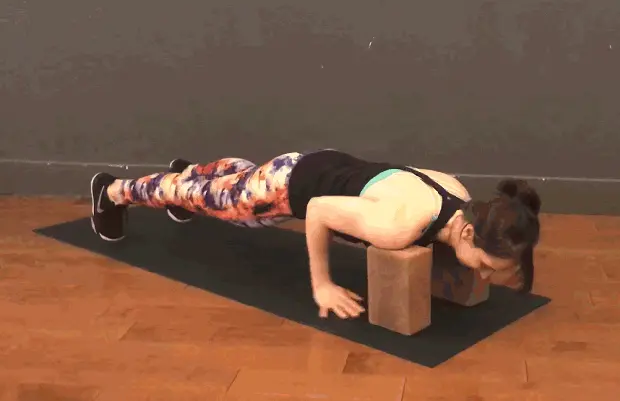
- Begin in a high plank with blocks at your fingertips.
- Lower shoulders onto blocks.
- Keep elbows slightly bent to protect joints.
- Lift right hand, then left, extending arms back.
- Engage core and glutes for stability.
- Hold for 30 seconds or as long as possible.
- Focus on steady breathing.
6. Single-Leg Romanian Deadlift

- Stand with left foot on a block.
- Ensure the block is stable beneath your foot.
- Lean forward, extending your right leg.
- Maintain a flat back to engage the hamstrings and glutes.
- Keep back balanced, and engage your core and glutes.
- Squeeze glutes to return to the standing position.
- Repeat for 8-10 reps.
7. Single-Leg Glute Bridge
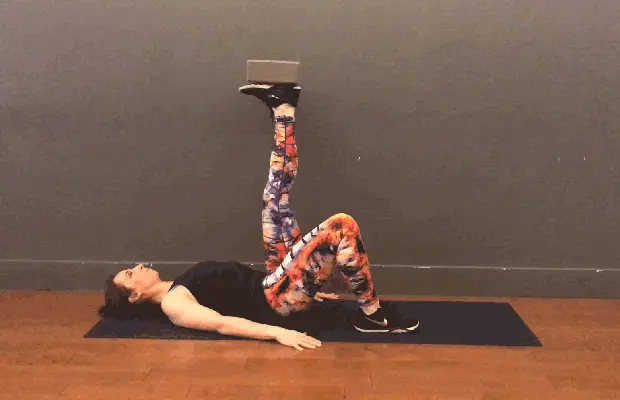
- Lie on your back with a block on your left foot.
- Lift hips, engaging glutes and abs.
- Press through the heel to engage the glutes.
- Lower hips and repeat.
- Maintain a straight line from shoulders to knees.
- Perform 8-10 reps.
Tips for Choosing the Right Yoga Block Size
- Yoga blocks come in various sizes.
- Choose a height that allows proper alignment for the pose.
- Experiment with turning the block onto different edges to adjust the height.
- Proper alignment enhances your yoga practice and promotes greater strength and flexibility.
Conclusion
Incorporating yoga blocks into your practice enhances your flexibility, strength, and balance and adds creativity to your routine. These beginner-friendly yoga block exercises challenge and invigorate your practice, allowing you to discover new depths in familiar poses. The next time you need to shake up your routine, grab your trusty yoga block exercises and embark on a journey of self-discovery and transformation. Elevate your yoga practice with the magic of yoga blocks!
FAQs
Can beginners use yoga blocks?
Absolutely! Yoga blocks are especially beneficial for beginners, providing support and making poses more accessible.
How do I choose the right size of yoga block?
Experiment with different sizes and edges to find the height that allows proper alignment for the pose you’re attempting.
Are yoga blocks only for beginners?
No, yoga blocks are versatile and can be used by practitioners of all levels. They can make both accessible and more challenging.
Can I use props like yoga blocks in any yoga?
Yes, props like yoga blocks can be used in various styles of yoga, including restorative, yin, and hatha.

